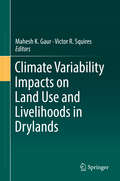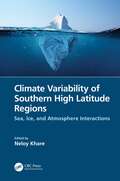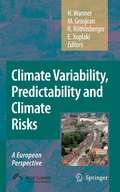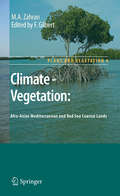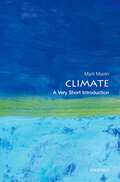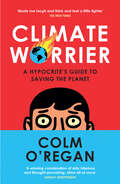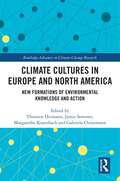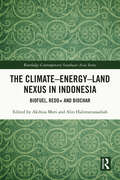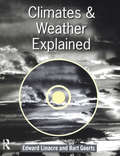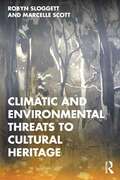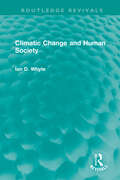- Table View
- List View
Climate Variability Impacts on Land Use and Livelihoods in Drylands
by Mahesh K. Gaur Victor R. SquiresThis edited volume is devoted to the examination of the implications of the inevitable changes wrought by global change on the welfare and livelihoods of tens of millions of people who live in dryland regions. Global change is more than just climate change and the ramifications of changing trade patterns (geopolitical and economic aspects), the shift to the market economy, demographic factors (population growth, urbanization and re-settlement), receive attention here. Land use change specialists, policy makers and natural resource management agencies will find the book very useful.Chapters focus on examples that are drawn from a number of sources including previously unpublished studies on the impact of climate change, markets and economics on pastoralist and dryland farming households. The key focus is to provide readers with insights into the real world implications of change (including an analysis of the drivers of change) on these vulnerable groups within dryland societies. The role of humans as agents of these changes is canvassed. A regional analysis of the world's drylands is also performed including those in Australia, Argentina, India, North America, China, North Africa, Central Asia and Southern Africa.
Climate Variability of Southern High Latitude Regions: Sea, Ice, and Atmosphere Interactions
by Neloy KhareThis is the first book to provide a comprehensive overview of climate change–related investigations carried out by Indian researchers through initiatives in southern high latitude regions. It explains climate variability over the Southern Ocean and Antarctica; air, sea, ice, and atmosphere interactions; and the impact of climate variability on sea ice and the polar atmosphere. The data were gathered at two Indian research bases, Maitri and Bharti, which are ideal sites to study and understand climatic evolution in Antarctic in the past and recent changes. This book helps to understand climatological perspectives and to evaluate some of the most pressing issues in the south polar region. FEATURES Highlights the achievements of India in the contemporary field of Antarctic climatology Presents four decades of research by Indian scientists in Antarctica, which is now shared for the first time with the global community Includes case studies on climatological and environmental conditions of natural archives to shed light on climate scenarios in the Southern Ocean and Antarctic regions Covers various aspects of climate variability and induced air-sea-ice-atmosphere interactions This book is edited by one of the top scientists and researchers of India in the field of paleoclimatology, and the contributors are experts in the Antarctic region.
Climate Variability of Southern High Latitude Regions: Sea, Ice, and Atmosphere Interactions
by Neloy KhareThis is the first book to provide a comprehensive overview of climate change–related investigations carried out by Indian researchers through initiatives in southern high latitude regions. It explains climate variability over the Southern Ocean and Antarctica; air, sea, ice, and atmosphere interactions; and the impact of climate variability on sea ice and the polar atmosphere. The data were gathered at two Indian research bases, Maitri and Bharti, which are ideal sites to study and understand climatic evolution in Antarctic in the past and recent changes. This book helps to understand climatological perspectives and to evaluate some of the most pressing issues in the south polar region. FEATURES Highlights the achievements of India in the contemporary field of Antarctic climatology Presents four decades of research by Indian scientists in Antarctica, which is now shared for the first time with the global community Includes case studies on climatological and environmental conditions of natural archives to shed light on climate scenarios in the Southern Ocean and Antarctic regions Covers various aspects of climate variability and induced air-sea-ice-atmosphere interactions This book is edited by one of the top scientists and researchers of India in the field of paleoclimatology, and the contributors are experts in the Antarctic region.
Climate Variability, Predictability and Climate Risks: A European Perspective
by Heinz Wanner Martin Grosjean Regine Röthlisberger Elena XoplakiThis book provides an integrated assessment of issues related to climate variability and change, predictability and risks. It details both the technical aspects of variability and abrupt climate change and the agricultural and economical impacts and consequences.
Climate - Vegetation: Afro-Asian Mediterranean and Red Sea Coastal Lands (Plant and Vegetation #4)
by M.A. ZahranDeserts are unique ecosystems with their own biotic and abiotic components, and are often rich in renewable natural resources, the appropriate management of which can contribute significantly to the sustainable management of desert regions for the welfare of the people. Yet while there are many books on the flora of the countries fringing the important desert countries of the Mediterranean and Red Seas, there or few books reporting on their ecophysiology and vegetation ecology. This book presents the vegetation types of the African and Asian countries of the Mediterranean and Red Sea coastal regions, and discusses the ecological threats and economic applications of these critical resources. In particular, it examines the relationships between climate and vegetation, and discusses these within the context of desertification, agro-industrial applications, ecotourism and sustainable development. The book will provide a valuable reference for researchers and graduate students involved in plant ecology, biogeography, economic botany and environmental management in the Afro-Asian Mediterranean and Red Sea coastal regions, as well as other desert regions around the world.
Climate: A Very Short Introduction (Very Short Introductions Ser.)
by Mark MaslinIn this wide-ranging Very Short Introduction to climate, Mark Maslin considers all aspects of the global climate system, exploring and explaining the different components that control climate on Earth. He considers the processes that allow energy to reach the Earth and how it is redistributed around the planet by the ocean-atmosphere system; the relationship and differences between climate and the weather; how climate has affected life on Earth and human settlements; and the cyclic and quasi-cyclic features of climate such as the Milankovitch cycles and El Nino. He concludes by touching on the issue of climate change, and outlines some of the approaches that are now being taken to tackle it. ABOUT THE SERIES: The Very Short Introductions series from Oxford University Press contains hundreds of titles in almost every subject area. These pocket-sized books are the perfect way to get ahead in a new subject quickly. Our expert authors combine facts, analysis, perspective, new ideas, and enthusiasm to make interesting and challenging topics highly readable.
Climate Vulnerability and Resilience in the Global South: Human Adaptations for Sustainable Futures (Climate Change Management)
by G. M. Monirul Alam Michael O. Erdiaw-Kwasie Gustavo J. Nagy Walter Leal FilhoThis book provides hands-on conceptual, theoretical, and case study discussions on vulnerability and resilience in the global south. This book covers the core of adaptation strategies in developing countries context in an easy-to-follow theoretical and empirical examples. This book shares contemporary approaches on vulnerability, adaptation strategies, and resilience, which aim to assist its targeted audience (academics, policymakers, and practitioners) to understand and make informed decisions in a wide variety of real-world resilience situations.
Climate Worrier: A Hypocrite’s Guide to Saving the Planet
by Colm O’ReganBestselling author Colm O’Regan is a worrier. A professional one. Caution is his watchword. Risk aversion is his love language. Now Colm is grappling with the biggest worry of all: the whole ‘planet being on fire’ thing and how exactly we can help.
Climate Cultures in Europe and North America: New Formations of Environmental Knowledge and Action (Routledge Advances in Climate Change Research)
by Thorsten HeimannBringing together scholarly research by climate experts working in different locations and social science disciplines, this book offers insights into how climate change is socially and culturally constructed. Whereas existing studies of climate cultural differences are predominantly rooted in a static understanding of culture, cultural globalization theory suggests that new formations emerge dynamically at different social and spatial scales. This volume gathers analyses of climate cultural formations within various spaces and regions in the United States and the European Union. It focuses particularly on the emergence of new social movements and coalitions devoted to fighting climate change on both sides of the Atlantic. Overall, Climate Cultures in Europe and North America provides empirical and theoretical findings that contribute to current debates on globalization, conflict and governance, as well as cultural and social change. This book will be of great interest to students and scholars of climate change, environmental policy and politics, environmental sociology, and cultural studies.
Climate Cultures in Europe and North America: New Formations of Environmental Knowledge and Action (Routledge Advances in Climate Change Research)
by Thorsten Heimann Jamie Sommer Margarethe Kusenbach Gabriela ChristmannBringing together scholarly research by climate experts working in different locations and social science disciplines, this book offers insights into how climate change is socially and culturally constructed. Whereas existing studies of climate cultural differences are predominantly rooted in a static understanding of culture, cultural globalization theory suggests that new formations emerge dynamically at different social and spatial scales. This volume gathers analyses of climate cultural formations within various spaces and regions in the United States and the European Union. It focuses particularly on the emergence of new social movements and coalitions devoted to fighting climate change on both sides of the Atlantic. Overall, Climate Cultures in Europe and North America provides empirical and theoretical findings that contribute to current debates on globalization, conflict and governance, as well as cultural and social change. This book will be of great interest to students and scholars of climate change, environmental policy and politics, environmental sociology, and cultural studies.
The Climate–Energy–Land Nexus in Indonesia: Biofuel, REDD+ and biochar (Routledge Contemporary Southeast Asia Series)
by Akihisa Mori Alin HalimatussadiahThis book extends the framework of the climate-energy-land nexus to elucidate political, economic, social, and institutional factors and causal mechanisms that stringent climate targets bring about, rather than mitigate a disproportional heavy burden on the forest sector in Indonesia. Assessing climate, energy, agricultural, forest, and transmigration policies, and REDD+ and biochar solutions through a multidisciplinary approach, ranging from biological, agricultural, technological, economic, and institutional lenses, the book identifies the political-economic and socio-technical regimes that cause the crosssectoral transfer of responsibility for greenhouse gas emissions to palm-oil-based biofuel, imposing an excess burden on the forest sector and accelerating indirect land-use change. It also proposes possible countermeasures for agricultural and forest sectors, reconfirming that technical applications and integrated policymaking should trigger the socioeconomic changes that will make transformative change happen in Indonesia. As an analysis of the success, or otherwise, of stringent climate targets, policies, and technological and non-technological measures on the reduction of greenhouse gases, this book will be of great interest to students and scholars in the fields of environment & sustainability, Asian studies, energy, environment and agriculture, forestry, and agriculture & environmental sciences. It will also appeal to practitioners and policymakers tackling net-zero emissions and land and forest governance.
The Climate–Energy–Land Nexus in Indonesia: Biofuel, REDD+ and biochar (Routledge Contemporary Southeast Asia Series)
This book extends the framework of the climate-energy-land nexus to elucidate political, economic, social, and institutional factors and causal mechanisms that stringent climate targets bring about, rather than mitigate a disproportional heavy burden on the forest sector in Indonesia. Assessing climate, energy, agricultural, forest, and transmigration policies, and REDD+ and biochar solutions through a multidisciplinary approach, ranging from biological, agricultural, technological, economic, and institutional lenses, the book identifies the political-economic and socio-technical regimes that cause the crosssectoral transfer of responsibility for greenhouse gas emissions to palm-oil-based biofuel, imposing an excess burden on the forest sector and accelerating indirect land-use change. It also proposes possible countermeasures for agricultural and forest sectors, reconfirming that technical applications and integrated policymaking should trigger the socioeconomic changes that will make transformative change happen in Indonesia. As an analysis of the success, or otherwise, of stringent climate targets, policies, and technological and non-technological measures on the reduction of greenhouse gases, this book will be of great interest to students and scholars in the fields of environment & sustainability, Asian studies, energy, environment and agriculture, forestry, and agriculture & environmental sciences. It will also appeal to practitioners and policymakers tackling net-zero emissions and land and forest governance.
Climates and Societies - A Climatological Perspective: A Contribution on Global Change and Related Problems Prepared by the Commission on Climatology of the International Geographical Union (GeoJournal Library #36)
by Masatoshi Yoshino Manfred Domrös Annick Douguédroit Janusz Paszyński Lawrence C. NkemdirimThe impact of climate on human activities and the effect of humans on cli mate are two of the most important areas of inquiry in climatology. These interactions conducted through physical, chemical and biological process es were described as early as Roman and Greek times. Marcus Vitruvius (75-25 B. C. ), a famous Roman engineer and architect, made the following observation about the climatic conditions necessary for founding a city: Land ideal for the health is slightly elevated and there should be neither fog nor frost. The direction of the slope and the distance to the swamps, lakes, and beaches must also be considered. The prevailing wind directions, observed by a wind tower at the center of the city, like Horologium at Athens, should be taken into consideration in city planning. The main and narrow streets should be placed in the middle angle of the two prevailing wind directions. Then the location of the Pantheons and squares should be decided. The influence of humans on climate was a major subject for discussion in the 19th century, inspired in part, by the rapid industrial growth and expanding deforestation of the time. D. L. Howard wrote brilliant pieces on the climate of London in the 1830s, while G . P. Marsh discussed the effects of forests on precipitation in the U. S . A. in the second half of the 19th century.
Climates and Weather Explained
by Bart Geerts Edward LinacreClimates and Weather Explained is a comprehensive introduction to the study of the atmosphere integrating climatology and meteorology. Clear explanations of basic principles, concepts and processes are supported by a wealth of highly informative illustrations and a vast array of case studies demonstrating the relevance of weather and climate to everyday life. Focusing particularly on the Southern hemisphere the authors provide fresh insights into topical environmental concerns from global warming and natural hazards to sustainable global population. The textbook is supplemented by a unique interactive Student CD-ROM containing entirely additional material, for practical work and more advanced study. Closely related to each chapter of the book, the Student CD-ROM features: * Over 170 extra 'Notes', 40 illustrations and tables. * Multiple choice, self-assessment and practical exercises. * Extended glossary and key word searching * Hypertext presentation and extensive cross-referencing * A gallery of meteorological photographs in full colour A special Instructors' Resource Pack is also available containing an additional Instuctors'CD-ROM. For further information visit: website address here
Climates and Weather Explained: An Introduction From A Southern Perspective: Instructor's Resource Pack (includes Students' And Instructors' Cd-rom)
by Bart Geerts Edward LinacreClimates and Weather Explained is a comprehensive introduction to the study of the atmosphere integrating climatology and meteorology. Clear explanations of basic principles, concepts and processes are supported by a wealth of highly informative illustrations and a vast array of case studies demonstrating the relevance of weather and climate to everyday life. Focusing particularly on the Southern hemisphere the authors provide fresh insights into topical environmental concerns from global warming and natural hazards to sustainable global population. The textbook is supplemented by a unique interactive Student CD-ROM containing entirely additional material, for practical work and more advanced study. Closely related to each chapter of the book, the Student CD-ROM features: * Over 170 extra 'Notes', 40 illustrations and tables. * Multiple choice, self-assessment and practical exercises. * Extended glossary and key word searching * Hypertext presentation and extensive cross-referencing * A gallery of meteorological photographs in full colour A special Instructors' Resource Pack is also available containing an additional Instuctors'CD-ROM. For further information visit: website address here
Climates, Landscapes, and Civilizations (Geophysical Monograph Series #198)
by Liviu Giosan Dorian Q. Fuller Kathleen Bisset Nicoll Rowan K. Flad Peter D. CliftPublished by the American Geophysical Union as part of the Geophysical Monograph Series, Volume 198.Climates, Landscapes, and Civilizations brings together a collection of studies on the history of complex interrelationships between humans and their environment by integrating Earth science with archeology and anthropology. At a time when climate change, overpopulation, and scarcity of resources are increasingly affecting our ways of life, the lessons of the past provide multiple reference frames that are valuable for informing our future decisions and action plans. Volume highlights include discussions of multiple connotations of the Anthropocene, landscapes as a link between climate and humans, synoptic approaches to explore large-scale cultural patterns, regional studies for contextualizing cultural complexity, and environmental determinism and social theory. Straddling the fields of Earth sciences, anthropology, and archaeology and presenting research from across several continents, Climates, Landscapes, and Civilizations will appeal to a wide readership among scientists, scholars, and the public at large.
Climates, Landscapes, and Civilizations (Geophysical Monograph Series #198)
by Liviu Giosan Dorian Q. Fuller Kathleen Nicoll Rowan K. Flad Peter D. CliftPublished by the American Geophysical Union as part of the Geophysical Monograph Series, Volume 198.Climates, Landscapes, and Civilizations brings together a collection of studies on the history of complex interrelationships between humans and their environment by integrating Earth science with archeology and anthropology. At a time when climate change, overpopulation, and scarcity of resources are increasingly affecting our ways of life, the lessons of the past provide multiple reference frames that are valuable for informing our future decisions and action plans. Volume highlights include discussions of multiple connotations of the Anthropocene, landscapes as a link between climate and humans, synoptic approaches to explore large-scale cultural patterns, regional studies for contextualizing cultural complexity, and environmental determinism and social theory. Straddling the fields of Earth sciences, anthropology, and archaeology and presenting research from across several continents, Climates, Landscapes, and Civilizations will appeal to a wide readership among scientists, scholars, and the public at large.
Climates of the British Isles: Present, Past and Future
by Elaine Barrow Mike HulmeOur understanding of climate and its role in human affairs has changed markedly over recent years, as have climate observation systems and modelling capabilities. Reliance on recent weather statistics to provide a guide for future climate is no longer viable. Evidence of human-induced climate change has placed climate high on political and the media agendas. Climates of the British Isles provides a comprehensive account of what we know about climate and changing climates at the end of the twentieth century. Integrating the historical and geographical dimensions of climate, the crucial link between past and future climatic conditions is examined through the geographical lens of the British Isles. Climates of past ages are reconstructed and full descriptions of present climate are illustrated by a wealth of graphs, maps and images. Important climate data sets are provided. Marking the twenty-fifth anniversary of the internationally acclaimed Climatic Research Unit, this book distils much of the leading research of present and recent members of the unit and presents an authoritative, accessible view of climatic change and prospects for the next millenium and beyond.
Climates of the British Isles: Present, Past and Future
by Mike Hulme Elaine BarrowOur understanding of climate and its role in human affairs has changed markedly over recent years, as have climate observation systems and modelling capabilities. Reliance on recent weather statistics to provide a guide for future climate is no longer viable. Evidence of human-induced climate change has placed climate high on political and the media agendas. Climates of the British Isles provides a comprehensive account of what we know about climate and changing climates at the end of the twentieth century. Integrating the historical and geographical dimensions of climate, the crucial link between past and future climatic conditions is examined through the geographical lens of the British Isles. Climates of past ages are reconstructed and full descriptions of present climate are illustrated by a wealth of graphs, maps and images. Important climate data sets are provided. Marking the twenty-fifth anniversary of the internationally acclaimed Climatic Research Unit, this book distils much of the leading research of present and recent members of the unit and presents an authoritative, accessible view of climatic change and prospects for the next millenium and beyond.
Climatic and Environmental History of Isla de los Estados, Argentina (SpringerBriefs in Earth System Sciences #0)
by Juan Federico Ponce Marilén FernándezThis book is the result of ten years’ of scientific research carried out by the authors on Isla de los Estados. The research includes their doctoral thesis and many published scientific papers related to the island.The book is divided into two principal parts. The first part covers different social and natural aspects of this remote island and includes chapters on the scientific and historical background, physiography with topographical and hydrographical descriptions, climate and oceanographic circulation, vegetation and geology (including stratigraphy, structural geology and geological history).The second part comprises a reconstruction of the paleoenvironmental, paleoclimatic and paleogeographic history of the island from the Last Glacial Maximum to the present, correlating with other paleoecological records from the southern part of Isla Grande de Tierra del Fuego and Patagonia. This second part also includes a geomorphological chapter with a characterization of the principal erosive glacial landforms on Isla de los Estados constructed by means of morphometric analysis, inventories, maps, paleogeographic and glacial models, and a paleoecological chapter evaluating the palaeoenvironment and palaeoclimatic conditions that prevailed during the Late Pleistocene-Holocene times based on pollen and diatom analysis from three 14C-dated peat bogs and lakes. Finally, the book concludes with a review of the island’s archaeology and the relationship between the palaeoenvironmental history and human occupation of this island.
Climatic and Environmental Threats to Cultural Heritage
by Robyn Sloggett Marcelle ScottClimatic and Environmental Threats to Cultural Heritage examines the challenges that environmental change, both sudden and long-term, poses to the preservation of cultural material. Acknowledging the diversity of human cultural heritage across collecting institutions, heritage sites and communities, the book highlights how, in Australia, Southeast Asia and the Pacific, the quest to preserve such precious knowledge relies on records and narratives being available to inform decisions now and into the future. Bringing together a diverse range of stakeholders who have an interest in – and responsibility for – the care of cultural heritage material and places of cultural heritage value, the book explores their thinking on and actions in relation to issues of climate change and environmental risk. Sloggett and Scott highlight the stakeholders’ shared interest in drawing on their expertise to meet the challenges that environmental change brings to the future of our cultural heritage and our cultural identity. Based on the understanding that this global challenge requires local, national and international co‐operation, the book also considers how local knowledge can have international application. Climatic and Environmental Threats to Cultural Heritage will be of interest to those engaged in the study of heritage, conservation, archaeology, archives, anthropology, climate change and the environment. It will also be useful to practitioners and others attempting to understand the effect of environmental change on cultural heritage around the globe.
Climatic and Environmental Threats to Cultural Heritage
by Robyn Sloggett Marcelle ScottClimatic and Environmental Threats to Cultural Heritage examines the challenges that environmental change, both sudden and long-term, poses to the preservation of cultural material. Acknowledging the diversity of human cultural heritage across collecting institutions, heritage sites and communities, the book highlights how, in Australia, Southeast Asia and the Pacific, the quest to preserve such precious knowledge relies on records and narratives being available to inform decisions now and into the future. Bringing together a diverse range of stakeholders who have an interest in – and responsibility for – the care of cultural heritage material and places of cultural heritage value, the book explores their thinking on and actions in relation to issues of climate change and environmental risk. Sloggett and Scott highlight the stakeholders’ shared interest in drawing on their expertise to meet the challenges that environmental change brings to the future of our cultural heritage and our cultural identity. Based on the understanding that this global challenge requires local, national and international co‐operation, the book also considers how local knowledge can have international application. Climatic and Environmental Threats to Cultural Heritage will be of interest to those engaged in the study of heritage, conservation, archaeology, archives, anthropology, climate change and the environment. It will also be useful to practitioners and others attempting to understand the effect of environmental change on cultural heritage around the globe.
Climatic Change and Global Warming of Inland Waters: Impacts and Mitigation for Ecosystems and Societies
by Charles R. Goldman Michio Kumagai Richard D. RobartsEffects of global warming on the physical, chemical, ecological structure and function and biodiversity of freshwater ecosystems are not well understood and there are many opinions on how to adapt aquatic environments to global warming in order to minimize the negative effects of climate change. Climatic Change and Global Warming of Inland Waters presents a synthesis of the latest research on a whole range of inland water habitats – lakes, running water, wetlands – and offers novel and timely suggestions for future research, monitoring and adaptation strategies. A global approach, offered in this book, encompasses systems from the arctic to the Antarctic, including warm-water systems in the tropics and subtropics and presents a unique and useful source for all those looking for contemporary case studies and presentation of the latest research findings and discussion of mitigation and adaptation throughout the world. Edited by three of the leading limnologists in the field this book represents the latest developments with a focus not only on the impact of climate change on freshwater ecosystems but also offers a framework and suggestions for future management strategies and how these can be implemented in the future. Limnologists, Climate change biologists, fresh water ecologists, palaeoclimatologists and students taking relevant courses within the earth and environmental sciences will find this book invaluable. The book will also be of interest to planners, catchment managers and engineers looking for solutions to broader environmental problems but who need to consider freshwater ecology.
Climatic Change and Global Warming of Inland Waters: Impacts and Mitigation for Ecosystems and Societies
by Charles R. Goldman Michio Kumagai Richard D. RobartsEffects of global warming on the physical, chemical, ecological structure and function and biodiversity of freshwater ecosystems are not well understood and there are many opinions on how to adapt aquatic environments to global warming in order to minimize the negative effects of climate change. Climatic Change and Global Warming of Inland Waters presents a synthesis of the latest research on a whole range of inland water habitats – lakes, running water, wetlands – and offers novel and timely suggestions for future research, monitoring and adaptation strategies. A global approach, offered in this book, encompasses systems from the arctic to the Antarctic, including warm-water systems in the tropics and subtropics and presents a unique and useful source for all those looking for contemporary case studies and presentation of the latest research findings and discussion of mitigation and adaptation throughout the world. Edited by three of the leading limnologists in the field this book represents the latest developments with a focus not only on the impact of climate change on freshwater ecosystems but also offers a framework and suggestions for future management strategies and how these can be implemented in the future. Limnologists, Climate change biologists, fresh water ecologists, palaeoclimatologists and students taking relevant courses within the earth and environmental sciences will find this book invaluable. The book will also be of interest to planners, catchment managers and engineers looking for solutions to broader environmental problems but who need to consider freshwater ecology.
Climatic Change and Human Society (Routledge Revivals)
by Ian D. WhyteOriginally published in 1995, this book brings together material from many sources and offers a balanced appreciation of the ways in which climatic changes can interact with society. The questions it discusses are as relevant now as when the book was published: how far should governments go in taking expensive and unpopular measures to reduce greenhouse gas emissions? Will the warming trend produce results as dire as have been predicted? It does not presuppose a background in science and extensive use is made of case studies drawn from around the world to put scientific principles into context. An invaluable book for those approaching the subject for the first time.
